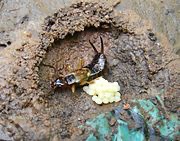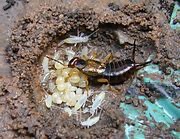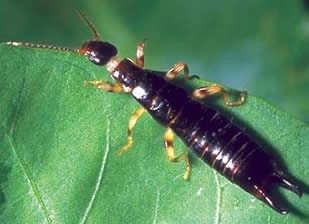
Easy to identify both the adults and nymphs have characteristic “pinchers” or forceps-like structures on the back end of their bodies. The body is black to brown in color and somewhat flattened. Nymphs do not have wings and adults have membranous wings folded underneath short cover-like forewings and they rarely fly. They have 3 pairs of well-developed legs. They make up the insect order Dermaptera. 12 families with about 2,000 species living in the world, and 20 of those species are living in the United States. They are one of the smaller insect orders. About 10 of species occur in Texas, and only a few are common. The ringleted earwig, has yellow legs with dark bands or rings on the segments. The riparian earwig, the linear earwig, and the brown-winged earwig.

Life Cycle: Earwigs are hemimetabolous, that means they undergo incomplete metamorphosis, they develop through a series of 4 to 6 molts. The developmental stages between molts are called instars. They live for about a year from hatching. They will start mating in the autumn, and can be found together in the autumn and winter. The male and female will live in a chamber in debris, crevices, or soil 2.5 centimeters (1”) deep. After mating the sperm may remain in the female for months before the eggs are fertilized. Earwigs prefer high moisture and migrate indoors during periods of prolonged heat and drought to seek cool, moist hiding places. During the winter they can dig into the ground as deep as 6 feet to escape freezing temperatures.

From midwinter to early spring the male will leave, or be driven out the the female. Afterwards the female will begin to lay 20 to 300 pearly white eggs in 2 days. When first laid, the eggs are white or cream-colored and oval-shaped, but right before hatching the become kidney-shaped and brow. Two generations are produced each year.
Earwigs are among the few non-social insect species that show maternal care. The mother will pay close attention to the needs of her eggs, such as warmth and protection, though studies have shown that the mother does not pay attention to the eggs as she collects them. The mother will defend the eggs from predators, not leaving them to eat unless the clutch (eggs) goes bad. Another distinct maternal care unique to earwigs is that the mother continuously cleans the eggs to protect them from fungi.
The eggs will hatch in about 7 days. The mother may assist the nymphs in hatching. The nymphs eat the egg casing and continue to live with the mother. Nymphs are similar to adults only smaller. They will net under their mother for protection until their second molt. Nymphs feed on regurgitated food by the mother they will also eat their own molts. Nymphs have been known to eat the mother if she dies before the nymphs are ready to live the nest.

Habitat and Food Source(s): Earwigs are active at night and seek dark places during the day such as underneath rocks, bark, plant debris, and between foundations and soil. They also occur indoors, particularly during periods of unfavorable outdoor conditions. They feed mainly on both dead and living insects and mosses, lichens, algae and fungi. Indoors, their food consists of sweet, oily and greasy foods. One earwig, the European earwig feeds at night on leaves of plants.
Pest Status: Generally harmless; they feed mainly on arthropods and decaying organic matter. They can be a nuisance when they invade homes.